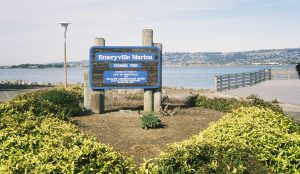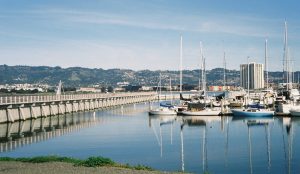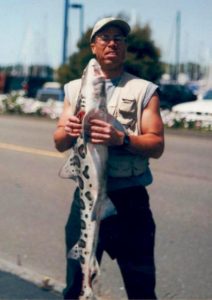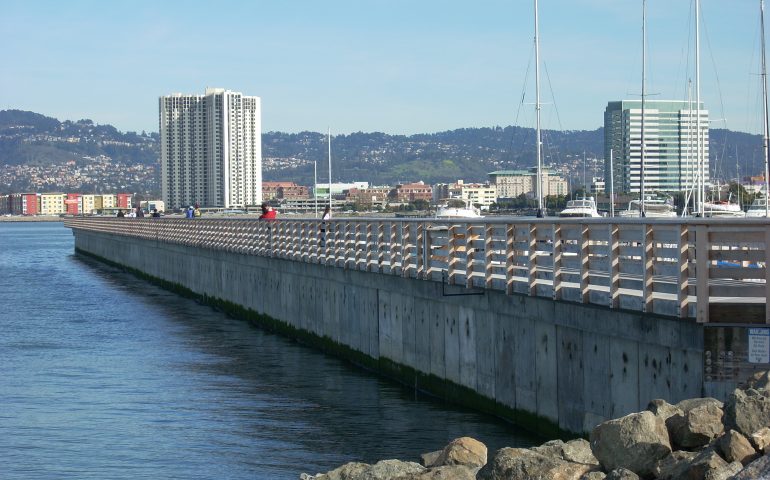Public Pier — No Fishing License Required
This is another East Bay pier that is mostly overlooked by fishermen. Just down the road is the Berkeley Pier, longer, more famous, and much more visited. However, a growing number of anglers visit this pier, a pier first opened in 1979. The pier is very accessible, well maintained, has good facilities and, most important, provides better protection from the wind than does Berkeley Pier. It also offers Marina Park (near the entrance to the pier) if the children get tired of fishing.

Environment. This 880-foot-long pier is built next to the Emeryville City Marina and in fact acts as a breakwater for the north side of the harbor. A wall is built directly under the pier to prevent current, surge, or waves from disrupting the water and boats in the harbor. This provides safety for the harbor but is not as attractive for fish as pier pilings that allow water to circulate around and through them. As a result, fishing at this pier is best done away from the pier—with the exception of winter or early spring when you may still find some perch around the pilings—particularly inshore near the rocks. Bottom here is mud and the current can be strong as water is forced along the inner wall. Anglers can cast out into deeper water or fish the more sheltered and shallow inner harbor area; my experience indicates that the deeper water is more productive. Adjacent to the front of the pier is an old loading ramp; I have caught several fish in the deeper water just out from the ramp (including a 50+ pound bat ray).

Fishing Tips. Fish here during the winter or early spring for pileperch, blackperch, rubberlip seaperch or white seaperch. Use a high/low leader, size 4-8 hooks, and pile worms, ghost shrimp, mussel or bits of ocean shrimp for bait. As mentioned, the inshore area near the rocky shoreline is often the best area for these larger perch.
Fish at night, in the summer and fall, for brown smoothhound sharks, leopard sharks, bat rays and striped bass. Use live midshipmen for the larger leopard sharks; squid, mackerel, sardines or anchovies for other sharks and rays. Remember to bring a net or treble-hook gaff since many of the bat rays are large.

PFIC member Red Fish and a leopard shark from the pier
Anglers who concentrate on striped bass typically use sardines, anchovies or pile worms although live shinerperch can also be productive. You might want to try artificial lures (especially on early evening incoming tides). Bass exceeding 40-pounds have been taken from the pier.
During much of the summer you may also latch onto a white croaker (kingfish) if you cast out away from the pier; use cut anchovies fished near the bottom for the kingfish, and remember that they will often hit the bait as it is sinks from the cast. An especially small kingfish can sometimes make excellent striper bait. The same bait and rig may also attract a sand sole.
A few halibut may also be landed, generally from May until September. Best bait for these are live anchovies if you can procure them (go to the Berkeley Marina Bait Shop). Most people can’t, so the next best bait is a live shinerperch or a small smelt. For all of these, use a sliding leader fished directly on the bottom.
Last but not least is to fish with three small, size 8 or 6 hooks, and small pieces of pile worms or shrimp for jacksmelt. Fish just under the surface of the water using a float or large bobber.
<*}}}}}}}}}>< — Special Bay Area Regulations:
- A perch closure exits in San Francisco and San Pablo Bay from April 1 to July 31. No perch may be kept other than shinerperch (20).
- In San Francisco and San Pablo Bay a fishing line may not contain more than three hooks.
Sturgeon Regulations:
- A sturgeon report card and tags are required for anyone fishing for or taking sturgeon. (a) The card must be in the angler’s possession; (b) a tag must be used for any sturgeon retained by the angler; (c) the angler must record information on the Sturgeon Report Card immediately after catching and keeping or releasing the sturgeon.
- White sturgeon can only be kept from 40-60 inches; larger and smaller sturgeon must be released.
- Green sturgeon may not be taken or possessed.
History Note. The town is named for Joseph S. Emery who, in 1859, bought the land that today is Emeryville. The marina and pier themselves sit at the end of the artificial one-mile-long peninsula which juts out into the bay. The peninsula was one of the last major fill projects allowed on the bay.
Emeryville Marina Fishing Pier Facts
Hours: Although the pier has no gates, the park in which the pier sits is now closed from 9 p.m. to 7 a.m.
Facilities: Free parking and restrooms are near the entrance to the pier. Fish cleaning stations, lights, and benches are on the pier. Bait and tackle and some food is available at Hank Schramm’s Emeryville Sportfishing Center which you will pass shortly before you get to the pier.
Handicapped Facilities: There are some handicapped parking spaces and restrooms are marked for the handicapped. The pier surface is concrete and the railing is approximately 40 inches high.
How To Get There: From I80 take the Powell Street exit in Emeryville, head west and simply follow the road to the end where you will find a small park and the pier.
Management: City of Emeryville.
